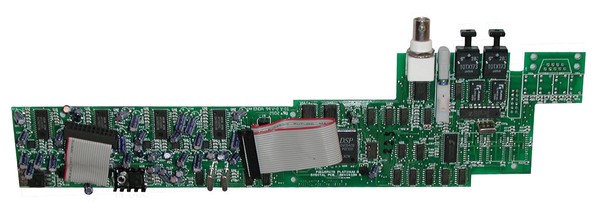blue_luke
Well-known member
This thread is the following of a thread that was started in the brewery " Trying to get in touch with wavefront semi"
JD you're right of course. ;D in theory.
In practice my system is based around two RME fireface 800. If you people know anything about RME, their WC is one of the very good in the business, so in pratice, I feel that I would get less jitter if I used my RME as master WC and slave the preamps converter to it.
My reasoning is that building a clock with less than a few parts in million deviation with what the average DIYfer like me can get is tougher than slaving to the WC.
Also in my system I use a video blackburst master signal that I distribute to my racks. Each racks contain a pro-tool video slave driver. End of the story here, but NO 96Ksamples possible, 44 or 48 only.
(I do multitrack live recording as a sideline business)
I looked around and it seems that SM pro has discontinued the adat converter they had (A0-8 and PR8IIa),
Rats!!
I checked MARIAN ADCON . They do good stuff but I don't need the ADAT to analogue converters, I checked also APHEX and it seems to be the best solution right now.
But I realy like the idea of building the converters in the mic preamp box, saves rack space, power cable and audio clutter... It's simply a neat idea.
I checked again, first reading really, on the wavefront site the pdf document they have about the ADAT chip and they discuss somewhat the protocol, but funny enough, no more application notes there!! :
So here we are, wanting a cookie from the jar, but daddy has put the jar on the top shelf. :'(
Luc
JD said
For best jitter performance you do want to use your preamp/converter's clock as WC master.
JD you're right of course. ;D in theory.
In practice my system is based around two RME fireface 800. If you people know anything about RME, their WC is one of the very good in the business, so in pratice, I feel that I would get less jitter if I used my RME as master WC and slave the preamps converter to it.
My reasoning is that building a clock with less than a few parts in million deviation with what the average DIYfer like me can get is tougher than slaving to the WC.
Also in my system I use a video blackburst master signal that I distribute to my racks. Each racks contain a pro-tool video slave driver. End of the story here, but NO 96Ksamples possible, 44 or 48 only.
(I do multitrack live recording as a sideline business)
I looked around and it seems that SM pro has discontinued the adat converter they had (A0-8 and PR8IIa),
Rats!!
I checked MARIAN ADCON . They do good stuff but I don't need the ADAT to analogue converters, I checked also APHEX and it seems to be the best solution right now.
But I realy like the idea of building the converters in the mic preamp box, saves rack space, power cable and audio clutter... It's simply a neat idea.
I checked again, first reading really, on the wavefront site the pdf document they have about the ADAT chip and they discuss somewhat the protocol, but funny enough, no more application notes there!! :
So here we are, wanting a cookie from the jar, but daddy has put the jar on the top shelf. :'(
Luc



